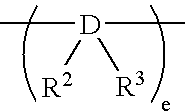Heat-storage material composition
a technology of heat storage material and composition, which is applied in the direction of heat exchange elements, heat production devices, chemistry apparatus and processes, etc., can solve the problems of increased cost, loss of practicability, and inability to completely prevent paraffin from bleeding, etc., and achieves excellent stability and less bleeding. , the effect of sticking
- Summary
- Abstract
- Description
- Claims
- Application Information
AI Technical Summary
Benefits of technology
Problems solved by technology
Method used
Image
Examples
production example 1
Production of (1,2′-dimethylsilylene)(2,1′-dimethylsilylene)bis(3-trimethylsilylmethylindenyl)zirconium dichloride
(1) Production of 2-chlorodimethylsilylindene
[0272] A three neck flask of one liter was charged with 50 ml of THF (tetrahydrofuran) and 2.5 g (41 millimole) of magnesium under nitrogen flow, and 0.1 ml of 1,2-dibromoethane was added thereto, followed by stirring the solution for 30 minutes to activate magnesium.
[0273] After stirring, the solvent was removed, and 50 ml of fresh THF was added thereto.
[0274] A THF (200 ml) solution of 5.0 g (25.6 millimole) of 2-bromoindene was dropwise added thereto in 2 hours.
[0275] After finishing dropwise adding, the solution was stirred at room temperature for 2 hours and then cooled down to −78° C., and a THF (100 ml) solution of 3.1 ml (25.6 millimole) of dichlorodimethylsilane was dropwise added thereto in one hour. The solution was stirred for 15 hours, and then the solvent was distilled off.
[0276] The residue was extracted ...
example 1
Production of Higher α-olefin Polymer using α-olefin having 18 Carbon Atoms Making use of the Catalyst Prepared in Production Example 1
[0295] An autoclave of 1 liter which was dried by heating was charged with 200 ml of heptane, 200 ml of 1-octadecene (C18), 1.0 millimole of triisobutylaluminum and 1.0 millimole of methylaluminoxane, and 0.03 MPa of hydrogen was further introduced thereinto.
[0296] The temperature was controlled to 60° C. while stirring, and then added thereto was 1.0 micromole of (1,2′-dimethylsilylene)(2,1′-dimethylsilylene)bis(3-trimethylsilylmethylindenyl)zirconium dichloride obtained in Production Example 1 to carry out polymerization for 60 minutes.
[0297] After finishing the polymerization reaction, a reaction product was deposited by repeating reprecipitation operation with acetone, and it was dried by heating under reduced pressure, whereby 50.7 g of a higher α-olefin polymer was obtained.
[0298] The α-olefin polymer thus obtained had a melting point (Tm) ...
example 2
Production of Higher α-olefin Polymer using α-olefin having 16 Carbon Atoms Making use of the Catalyst Prepared in Production Example 1
[0300] An autoclave of 1 liter which was dried by heating was charged with 200 ml of heptane, 200 ml of 1-hexadecene (C16), 1.0 millimole of triisobutylaluminum, 2.0 millimole of methylaluminoxane and 2 micromole of (1,2′-dimethylsilylene)(2,1′-dimethylsilylene)bis(3-trimethylsilylmethylindenyl)zirconium dichloride obtained in Production Example 1, and 0.05 MPa of hydrogen was further introduced thereinto to carry out polymerization at a polymerization temperature of 60° C. for 120 minutes.
[0301] After finishing the polymerization reaction, a reaction product was deposited with acetone, and then it was dried by heating under reduced pressure, whereby 81 g of a higher α-olefin polymer was obtained.
[0302] The α-olefin polymer thus obtained had a melting point (Tm) of 28.0° C.
[0303] The measuring results of the physical properties of the polymer obt...
PUM
| Property | Measurement | Unit |
|---|---|---|
| Temperature | aaaaa | aaaaa |
| Temperature | aaaaa | aaaaa |
| Temperature | aaaaa | aaaaa |
Abstract
Description
Claims
Application Information
 Login to View More
Login to View More - R&D Engineer
- R&D Manager
- IP Professional
- Industry Leading Data Capabilities
- Powerful AI technology
- Patent DNA Extraction
Browse by: Latest US Patents, China's latest patents, Technical Efficacy Thesaurus, Application Domain, Technology Topic, Popular Technical Reports.
© 2024 PatSnap. All rights reserved.Legal|Privacy policy|Modern Slavery Act Transparency Statement|Sitemap|About US| Contact US: help@patsnap.com










